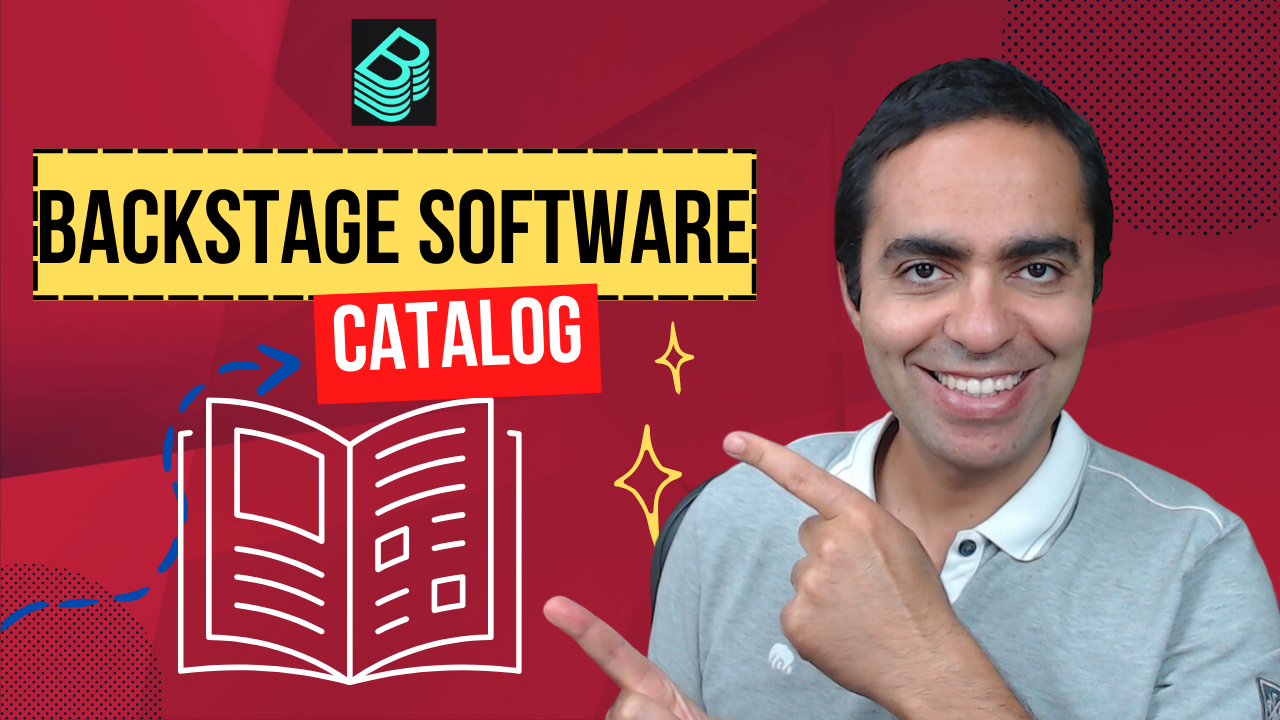Introduction
In today’s fast-paced and complex software development environment, managing and tracking numerous services, resources, and ownership information can be a daunting task. What if there was a centralized platform that could streamline this process and make it easier for developers to stay organized and efficient? Enter the Backstage Software Catalog, a powerful service catalog system that simplifies service management, enhances discoverability, and fosters collaboration across teams. Let’s dive into the world of the Backstage Software Catalog and explore how it can revolutionize the way you manage your tech stack.
Video
Below is a video demonstration.
Video Chapters
- 00:00 – Introduction Animation
- 05:01 – Demo
- 05:20 – Create a Component
- 06:57 – Access TeKanAid Academy
- 07:30 – A Node.js App on EKS via Terraform
- 08:13 – The Value of Platform Engineering
Key Takeaways
- Explore the open-source Backstage Software Catalog to manage services, metadata & ownership.
- Streamline your workflow with a centralized system for unified platform management and automated component registration.
- Leverage advanced features such as multi-cloud support, customizable search capabilities, and real-world use cases to simplify service onboarding & collaboration across teams.
Exploring the Backstage Software Catalog

Let’s take a step back and understand the history of Backstage.io:
- An open-source project launched by a team at Spotify
- Currently an Incubation project of the Cloud Native Computing Foundation (CNCF)
- Aims to provide a centralized service catalog system for effectively managing services, metadata, and ownership.
The foundation of the Backstage Software Catalog lies in the concept of metadata YAML files stored in conjunction with the code, allowing you to manage all your services. This simplifies the development process by offering a single platform for managing various services and resources within your organization.
Centralized System for Service Management
Backstage streamlines the developer experience through a unified platform, managing multiple services and resources within an organization, including software components. It provides a single point of contact for all service-related activities, streamlining service requests, issues, and incidents. With Backstage’s centralized system, developers can locate the necessary services with ease, enhancing efficiency and productivity.
Processors, responsible for catalog ingestion tasks, are vital to the Backstage catalog. They perform tasks such as:
- Reading, parsing, transforming, and validating raw entity data from remote sources like data pipelines
- Adding locations to the catalog via the Catalog (UrlReaderProcessor) processor, which is included in the package
- Monitoring request statuses for adding locations through the Backstage UI
Component Metadata and Ownership

Backstage utilizes YAML files to define services and their relationships, providing visibility into ownership and dependencies. These metadata files, committed alongside the code, make it easy to track ownership and dependencies in the Backstage catalog. This approach ensures that you have a uniform overview of:
- The number of components
- The connections between them
- Ownership
- Access to documentation and APIs
This is especially useful for managing all the software in a system with multiple components, utilizing a version control system.
The catalog-info.yaml file forms the core of Backstage’s component metadata management. It allows you to:
- Define services and their properties
- Manage various services and related resources within your organization
- Facilitate the tracking of all PRs until completion
- Ensure that the catalog stays updated when a new repository is created or deleted.
Streamlined Developer Experience
Backstage enhances the development process with unified tooling while minimizing infrastructure complexity. It offers a single source of truth for all services, enabling developers to rapidly and conveniently access the services they require without manual configuration.
Furthermore, Backstage provides automated component registration, multi-cloud and Kubernetes support, and customizable search capabilities, all of which contribute to the simplification of infrastructure complexity.
Integrating Backstage into Your Workflow

Integrating the Backstage Software Catalog into your workflow can fully harness its potential.
This section outlines the steps to configure and register components with Backstage and discusses participation in the open-source community.
Installation and Configuration
If you haven’t installed backstage yet, check out our previous post called Unlocking Developer Bliss: A First Look At Backstage.io
Once Backstage is installed, you can start configuring your catalog by adding locations and pointing them to the corresponding YAML files. This process, known as static location configuration, will allow Backstage to display your services and their properties, making it easy to manage and track your software assets.
Defining Services with YAML Files
Crafting catalog-info.yaml files to define your services and their properties in Backstage simplifies service management. These files allow you to specify the services and their attributes, making it easy to keep the catalog updated and discoverable.
Maintaining consistent formatting and using descriptive names for services helps keep your catalog organized and user-friendly.
Registering Components with Backstage
The process of adding your services to the Backstage catalog is relatively straightforward. Here are the steps:
- Navigate to the catalog page at localhost:3000/catalog.
- Select “Create component” -> “Create component” then “Register existing component”.
- In the “Repository URL” input field, insert the Github URL that leads to your catalog-info.yaml file.
- Review the details before tapping on import.
- Upon successful registration, the component can be viewed in the catalog.
Contributing to the Open Source Community
Sharing custom plugins and integrations within the Backstage ecosystem can benefit both your organization and the broader open-source community.
- Contributing code and documentation can further the development of new features
- Enhance existing functionality
- Promote a collaborative environment among developers.
Joining the Backstage community, identifying issues to work on, submitting pull requests, and checking the pull request status are great ways to contribute to the technical direction of Backstage and support the ongoing growth of this powerful tool.
Real-World Use Cases for Backstage Software Catalog

The real potential of the powerful Backstage Software Catalog becomes apparent through real-world use cases. This section delves into how Backstage simplifies service onboarding, boosts discoverability, and fosters collaboration among teams.
We will now explore some practical applications of this innovative tool, such as URL target optimization.
Simplifying Service Onboarding
Backstage provides a centralized system for service management, component metadata, and ownership. Its streamlined developer experience simplifies the creation of new services adhering to best practices. Its templates and push-button deployment features allow engineers to quickly initiate new microservices aligned with the organization’s pre-defined best practices right from the onset.
The simplified service onboarding process reduces the time and effort needed to launch all the services, maintaining consistency across the organization.
Enhancing Discoverability and Accountability
Backstage enhances the visibility and tracking of software assets in your tech stack, simplifying the location and access to needed services. By providing a centralized system for managing services, Backstage ensures that ownership, dependencies, and request status are clearly defined and easy to track.
This enhances discoverability and fosters accountability within your organization, as teams can easily identify who is responsible for specific services or components through resource monitoring.
Facilitating Collaboration across Teams
Effective communication and cooperation among development teams are vital for the success of any software project. Providing a centralized system for managing services, component metadata, and ownership, Backstage promotes collaboration by making it easy for teams to discover and work with the resources they need.
Moreover, Backstage enables:
- Cross-functional collaboration, where individuals from different teams or departments can come together to work on a project, sharing their diverse skills and expertise
- Breaking down silos and fostering a more unified organization
- Empowering teams to work together more effectively and efficiently
- Driving continuous improvement and innovation
Advanced Features and Integrations
Beyond its core functionality, the Backstage Software Catalog boasts various advanced features and integrations that amplify its capabilities.
This section highlights the benefits of automated component registration, multi-cloud and Kubernetes support, and customizable search capabilities.
Multi-cloud and Kubernetes Support

Being cloud-agnostic, Backstage can operate with any cloud provider or managed Kubernetes service. This flexibility allows your organization to utilize the services and resources of various cloud providers, such as AWS, Azure, and Google Cloud, to suit your requirements.
Additionally, Backstage offers a unified UI for managing Kubernetes deployments, enabling users to efficiently deploy and manage applications across multiple cloud providers.
Customizable Search Capabilities

Backstage’s extensible backend and customizable search options create a personalized search experience, enabling users to:
- Index and locate any source
- Customize the appearance and presentation of search results
- Introduce search-as-you-type autocompletion
- Select particular websites or sources to be included in the search engine
By implementing these management features, along with other management features, you can ensure that your team can quickly and efficiently locate the information they need.
With Backstage, you can create a tailored search experience that meets the needs of your team
Summary
In conclusion, the Backstage Software Catalog is a powerful tool that can revolutionize the way you manage your tech stack. By providing a centralized system for managing services, metadata, and ownership, it simplifies the development process, enhances discoverability, and fosters collaboration across teams. With its advanced features and integrations, such as automated component registration, multi-cloud and Kubernetes support, and customizable search capabilities, Backstage is poised to become an indispensable asset to any software development organization.
Frequently Asked Questions
What is the alternative to Backstage Service Catalog?
For an alternative to Backstage, Configure8, Port, Cortex, OpsLevel, Effx, and Clutch are all available options. All of them have their own advantages and drawbacks compared to Backstage. I found that Backstage is highly configurable, but has a steeper learning curve whereas the others are easier to start with but not as flexible.
What is backstage software?
Backstage is an open-source platform developed by Spotify, enabling product teams to quickly ship high-quality code without compromising autonomy. Powered by a centralized software catalog, it restores order to microservices and infrastructure. Learn more from our previous blog post called What Is Backstage: Your Ultimate Guide To Streamlining Developer Tools
What is a software catalog?
A Software Catalog is a centralized system that keeps track of ownership and metadata for all software products, including information on acquiring, deploying and utilizing software. It is also an index during software scans to automatically identify the software installed on monitored computers.
What is the primary purpose of the Backstage Software Catalog?
The primary purpose of the Backstage Software Catalog is to provide a centralized service for effectively managing services, metadata, and ownership within an organization.
How does Backstage facilitate the service onboarding process?
Backstage makes service onboarding easy and efficient, providing developers with templates and push-button deployment features to quickly create new services following best practices.
Suggested Reading
- What Is Backstage: Your Ultimate Guide To Streamlining Developer Tools
- Unlocking Developer Bliss: A First Look At Backstage.io
- Powerful Backstage Templates | An EKS & Terraform Example
Code
Hi and Welcome!
Join the Newsletter and get FREE access to all my Source Code along with a couple of gifts.

